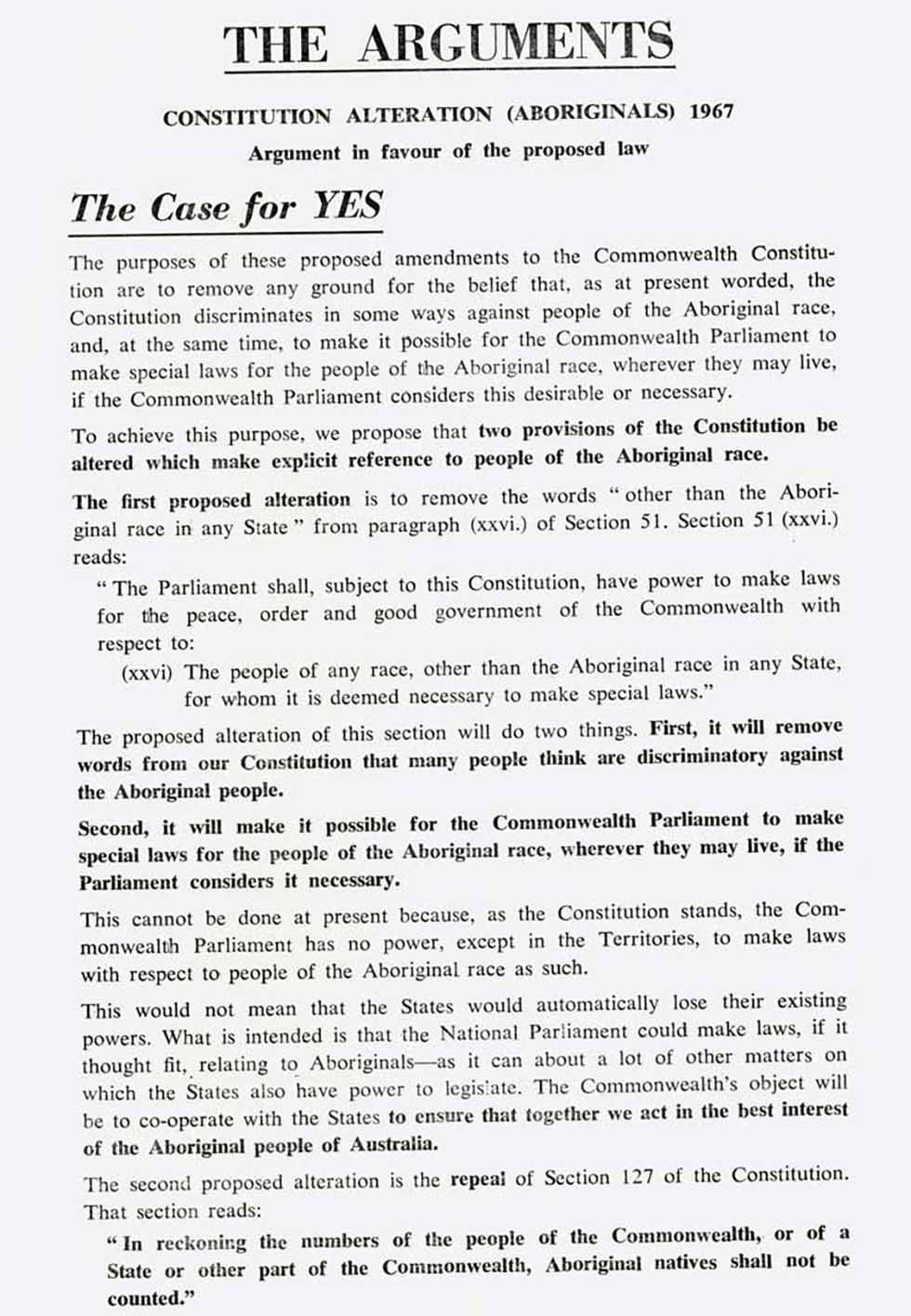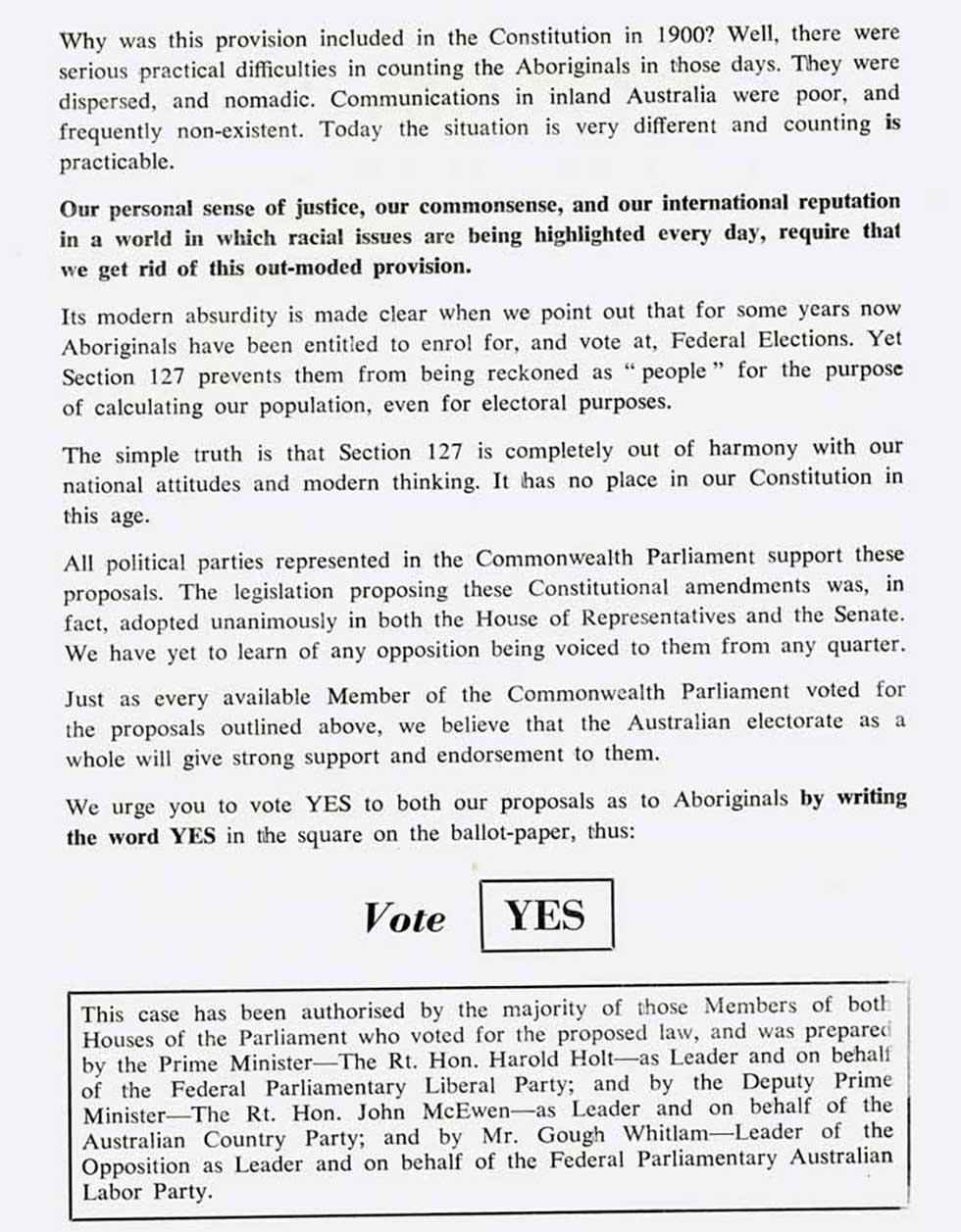
Item ID 3050230. Page number 34. Referendum 1967 – Proceedings in Parliament and submissions of case

Item ID 3050230. Page number 35. Referendum 1967 – Proceedings in Parliament and submissions of case
Aboriginal and Torres Strait Islander people should be aware that the National Archives' website and collection contain the names, images and voices of people who have died.
Some records include terms and views that are not appropriate today. They reflect the period in which they were created and are not the views of the National Archives.


Item ID 3050230. Page number 34. Referendum 1967 – Proceedings in Parliament and submissions of case

Item ID 3050230. Page number 35. Referendum 1967 – Proceedings in Parliament and submissions of case
[Page 1.]
[Underlined heading:] THE ARGUMENTS
CONSTITUTION ALTERATION (ABORIGINALS) 1967
Argument in favour of the proposed law
[Underlined subheading:] The Case for YES
The purposes of these proposed amendments to the Commonwealth Constitution are to remove any ground for the belief that, as at present worded, the Constitution discriminates in some ways against people of the Aboriginal race, and, at the same time, to make it possible for the Commonwealth Parliament to make special laws for the people of the Aboriginal race, wherever they may live, if the Commonwealth Parliament considers this desirable or necessary.
To achieve this purpose, we propose that [bold] two provisions of the Constitution be altered which make explicit reference to people of the Aboriginal race [end bold].
[Bold] The first proposed alteration [end bold] is to remove the words "other than the Aboriginal race in any State" from paragraph (xxvi.) of Section 51. Section 51 (xxvi.) reads:
[Indented quote:] "The Parliament shall, subject to this Constitution, have power to make laws for the peace, order and good government of the Commonwealth with respect to:
(xxvi.) The people of any race, other than the Aboriginal race in any State, for whom it is deemed necessary to make special laws." [end indented quote.]
The proposed alteration of this section will do two things. [Bold:] First, it will remove words from our Constitution that many people think are discriminatory against the Aboriginal people.
Second, it will make it possible for the Commonwealth Parliament to make special laws for the people of the Aboriginal race, wherever they may live, if the Parliament considers it necessary. [End bold.]
This cannot be done at present because, as the Constitution stands, the Commonwealth Parliament has no power, except in the Territories, to make laws with respect to people of Aboriginal race as such.
This would not mean that the States would automatically lose their existing powers. What is intended is that the National Parliament could make laws, if it thought fit, relating to Aboriginals- as it can about a lot of other matters on which the States also have power to legislate. The Commonwealth’s object will be to co-operate with the States [bold] to ensure that together we act in the best interest of the Aboriginal people of Australia. [end bold.]
The second proposed alteration is the [bold] repeal [end bold] of Section 127 of the Constitution.
That section reads:
[Indented, bolded quote:] "In reckoning the numbers of the people of the Commonwealth, or of a State or other part of the Commonwealth, Aboriginal natives shall not be counted." [End indented quote.]
[Page 2]
Why was this provision included in the Constitution in 1900? Well, there were serious practical difficulties in counting the Aboriginals in those days. They were dispersed, and nomadic. Communications in inland Australia were poor, and frequently non-existent. Today the situation is very different and counting is practicable.
[Bold:] Our personal sense of justice, our commonsense [sic], and our international reputation in a world in which racial issues are being highlighted every day, require that we get rid of this out-moded provision. [End bold.]
Its modern absurdity is made clear when we point out that for some years now Aboriginals have been entitled to enrol for, and vote at, Federal Elections. Yet Section 127 prevents them from being reckoned as "people" for the purpose of calculating our population, even for electoral purposes.
The simple truth is that Section 127 is completely out of harmony with our national attitudes and modern thinking. It has no place in our Constitution in this age.
All political parties represented in the Commonwealth Parliament support these proposals. The legislation proposing these Constitutional amendments was, in fact, adopted unanimously in both the House of Representatives and the Senate. We have yet to learn of any opposition being voiced to them from any quarter.
Just as every available Member of the Commonwealth Parliament voted for the proposals outlined above, we believe that the Australian electorate as a whole will give strong support and endorsement to them.
We urge you to vote YES to both our proposals as to Aboriginals [bold] by writing the word YES [end bold] in the square on the ballot-paper, thus:
[The word ‘Vote’ in large italicised text, next to a box with the word 'YES' written inside in large bold capitals.]
[The page ends with a paragraph in a box:] This case has been authorised by the majority of those Members of both Houses of Parliament who voted for the proposed law, and was prepared by the Prime Minister – The Rt. Hon. Harold Holt – as leader and on behalf of the Federal Parliamentary Liberal Party; and by the Deputy Prime Minister – The Rt. Hon. John McEwen – as Leader and on behalf of the Australian Country Party; and by Mr. Gough Whitlam- Leader of the Opposition as Leader and on behalf of the Federal Parliamentary Australian Labor Party.
This is the 'Yes' case prepared by parliamentarians in 1967 to summarise the arguments in favour of changing the Constitution to remove sections that discriminated against First Australians. All households in Australia with an enrolled voter were sent a copy of these arguments by the Australian Electoral Office.
An important part of the referendum process in Australia is the preparation and distribution of 'Yes' and 'No' cases. After a bill to change the Constitution has passed through the Australian Parliament, members of Parliament are divided into 'Yes' and 'No' committees, based on how they voted for the bill.
Each committee prepares a written argument – like the 'Yes' case seen here – to be distributed by mail to Australian voters. Reading these arguments enables voters to make an informed decision on referendum day.
In the 1967 referendum, no parliamentarian voted against the proposals for constitutional change relating to First Australians. As a result, only a 'Yes' committee was formed, and only a 'Yes' case was prepared and sent to voters.
The 'Yes' case explained to voters that the proposed changes to s51(xvii) would make it possible for the Parliament to make special laws for First Australians.
It also addressed the need to repeal s127 of the Constitution, which excluded First Australians from being counted as part of the Australian population:
our personal sense of justice, our common sense, and our international reputation in a world in which racial issues are being highlighted every day, require that we get rid of this out-moded provision.
Parliament's unanimous support for the 'Yes' case was reflected in a strong 'Yes' vote on referendum day. On 27 May 1967, over 90.77% of voters voted 'Yes' – the highest 'Yes' vote ever recorded in an Australian referendum.
Read the full 'Yes' case provided by the Australian Parliament. How persuasive do you find the wording of the 'Yes' case? Are there any other reasons for voting yes that you would have included if you were a member of the 'Yes' committee in 1967?
Learn how to interpret primary sources, use our collection and more.
